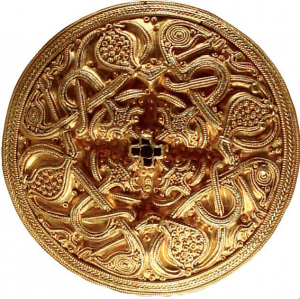One of the most stunning but lesser known archaeological finds in Germany is the 'Gold Jewellery of Hiddensee', which was discovered by chance in the 19th century on the tiny island in the Baltic. Since their discovery, the sixteen items in the hoard dating from the Viking Age have been presided over by the Kulturhistorisches Museum of the Hanseatic town of Stralsund.
All items of jewellery, including a brooch (fibula), a neck ring and 14 pendants are of pure gold and weigh some 600 g altogether. It is likely the jewellery originally belonged to the family of the Danish King, Harald Gormsson (died ca. 980), better known by his nickname, 'Bluetooth'.
Cross Motif
Undisputed is the connection with the „Viking" animal symbolism. The animal head in the centre could be the head of an eagle or an owl. However, some scientists speak of Greek-Byzantine influences; others see an astonishing similarity to the hammer form of the God Thor (from the northern mythology).
Fibula Motif
The cross in the centre can be evaluated as a Christian symbol. The Viking goldsmith art shows us finest intertwined gold wires, tender rosettes and tiny up-strewn balls of the gold granule. With some imagination one can see snakes with artfully entwined bodies. It could also be four dragon heads facing each other, whose bodies end in two-toed claws.
Neuendorf/Hiddensee, Rügen, Germany. Gold © Jutta Grudziecki, Kulturhistorisches Museum der Hansestadt Stralsund



